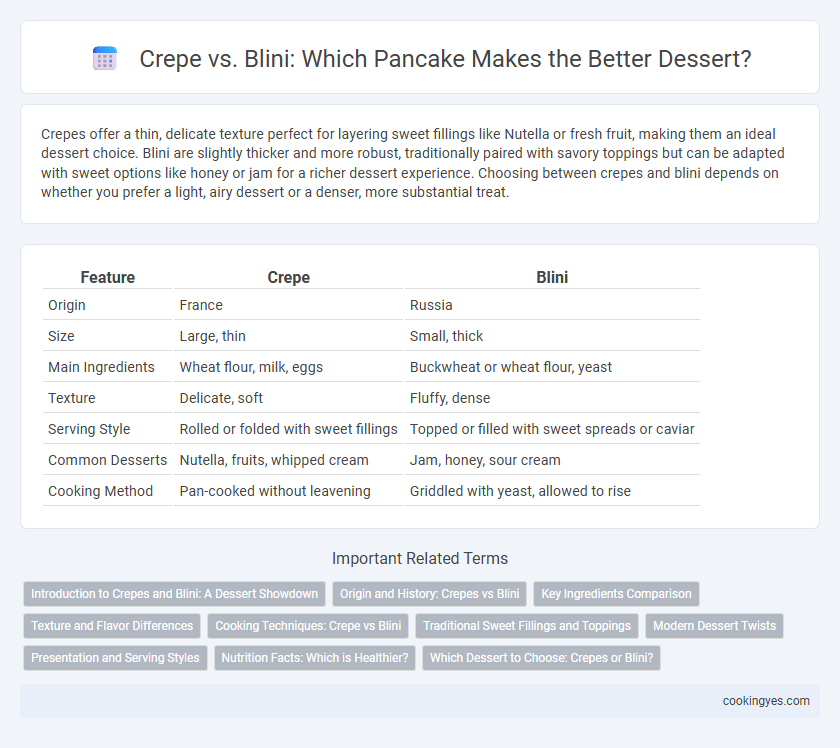Crepes offer a thin, delicate texture perfect for layering sweet fillings like Nutella or fresh fruit, making them an ideal dessert choice. Blini are slightly thicker and more robust, traditionally paired with savory toppings but can be adapted with sweet options like honey or jam for a richer dessert experience. Choosing between crepes and blini depends on whether you prefer a light, airy dessert or a denser, more substantial treat.
Table of Comparison
| Feature | Crepe | Blini |
|---|---|---|
| Origin | France | Russia |
| Size | Large, thin | Small, thick |
| Main Ingredients | Wheat flour, milk, eggs | Buckwheat or wheat flour, yeast |
| Texture | Delicate, soft | Fluffy, dense |
| Serving Style | Rolled or folded with sweet fillings | Topped or filled with sweet spreads or caviar |
| Common Desserts | Nutella, fruits, whipped cream | Jam, honey, sour cream |
| Cooking Method | Pan-cooked without leavening | Griddled with yeast, allowed to rise |
Introduction to Crepes and Blini: A Dessert Showdown
Crepes and blini are thin pancakes with distinct cultural origins and ingredients that shape their dessert profiles. Crepes, originating from France, are typically made with wheat flour and have a delicate, smooth texture ideal for sweet fillings like chocolate, fruit, or cream. Blini, rooted in Russian cuisine, use buckwheat or wheat flour and yeast, resulting in a slightly thicker, spongier base that pairs well with sweet toppings such as jam or honey.
Origin and History: Crepes vs Blini
Crepes originated in Brittany, France, dating back to the 13th century as a versatile thin pancake made from wheat flour, often enjoyed with sweet fillings. Blini have roots in Eastern Slavic traditions, notably Russia, and were initially prepared with buckwheat flour as a ritual symbol during pagan festivals celebrating the sun. Both pancakes represent rich cultural histories, with crepes evolving as delicate, delicate treats in French cuisine, while blini maintain their ceremonial significance in Slavic countries.
Key Ingredients Comparison
Crepes and blinis differ primarily in their base ingredients, where crepes are made from a smooth batter of flour, eggs, milk, and butter, resulting in a thin, flexible texture ideal for sweet fillings. Blinis incorporate yeast and sometimes buckwheat flour, lending them a thicker, spongier consistency with a slightly tangy flavor suited for richer toppings. The key ingredient variations impact the cooking technique and the dessert pairing options, making crepes more versatile for delicate fruit and cream fillings, while blinis complement cream cheese and caviar with a hearty bite.
Texture and Flavor Differences
Crepes feature a thin, delicate texture with a slightly crisp edge and a mild, buttery flavor that enhances sweet fillings like fruit preserves or chocolate. Blinis are thicker and spongier, offering a soft, porous texture with a subtle tang from fermentation that pairs well with rich, creamy toppings such as sweetened sour cream or honey. These textural and flavor differences make crepes ideal for light, smooth desserts, while blinis provide a heartier, more complex base for indulgent sweet combinations.
Cooking Techniques: Crepe vs Blini
Crepes require a thin batter poured evenly onto a hot, lightly greased skillet, cooked quickly on one or both sides to achieve a delicate, soft texture ideal for folding or rolling with sweet fillings. Blini batter is thicker and slightly fermented, cooked in small, round shapes on a greased griddle or frying pan, producing a fluffy, spongy texture often paired with rich toppings like sour cream or caviar. Precise temperature control and batter consistency are crucial for crepes' paper-thin quality and blinis' airy rise, highlighting distinct cooking techniques for these traditional desserts.
Traditional Sweet Fillings and Toppings
Crepes are traditionally filled with sweet ingredients such as Nutella, fresh berries, whipped cream, and powdered sugar, offering a delicate, thin texture that complements rich or fruity fillings. Blini, smaller and thicker, often feature toppings like sweetened sour cream, honey, or jam, aligning with Eastern European dessert customs. Both pancakes serve as versatile bases for classic sweet accompaniments but differ in texture and regional flavor profiles.
Modern Dessert Twists
Crepes offer versatile modern dessert twists with fillings like Nutella, fresh berries, and mascarpone, enhancing their thin, delicate texture. Blinis, traditionally savory, are increasingly adapted for desserts using sweet toppings such as honey, cinnamon, or fruit preserves for a fluffy, pillowy experience. Both crepes and blinis serve as excellent bases for innovative presentations in contemporary dessert menus.
Presentation and Serving Styles
Crepes offer a delicate, thin texture ideal for elegant folding or rolling, often filled with sweet ingredients like chocolate, fruit, or cream and presented with powdered sugar or drizzled syrups for a refined dessert appearance. Blinis are thicker and fluffier, typically served stacked or layered with toppings such as berries, honey, or sour cream, emphasizing a rustic and hearty presentation. Both pancakes support versatile plating, but crepes highlight finesse while blinis deliver a cozy, substantial feel for dessert.
Nutrition Facts: Which is Healthier?
Crepes and blinis differ in nutritional content, with crepes often containing fewer calories and less fat due to their thinner batter made primarily from flour, eggs, and milk. Blinis, typically made using yeast and sometimes buckwheat flour, provide more protein and fiber, contributing to better satiety and digestive health. Choosing between crepes and blinis depends on dietary goals: crepes suit low-calorie preferences, while blinis offer enhanced nutritional benefits like higher protein and fiber.
Which Dessert to Choose: Crepes or Blini?
Crepes offer a thin, delicate texture perfect for sweet fillings like Nutella, fruits, and whipped cream, making them ideal for dessert lovers seeking a light, versatile option. Blini are thicker, slightly yeasty pancakes traditionally paired with sweet toppings like sour cream and fruit preserves, adding a richer, heartier flavor profile. Choosing between crepes and blini for dessert depends on whether you prefer a tender, flexible base or a more robust, earthy taste complemented by classic Eastern European accompaniments.
Crepe vs Blini for dessert Infographic

 cookingyes.com
cookingyes.com